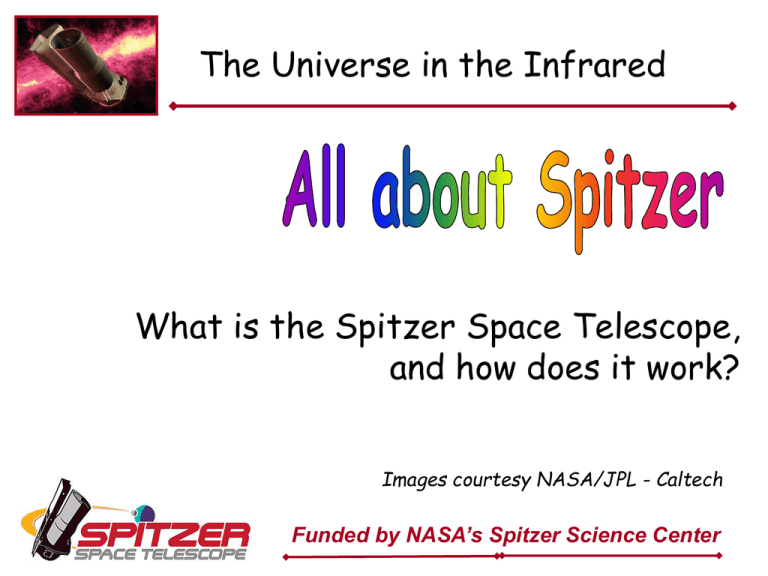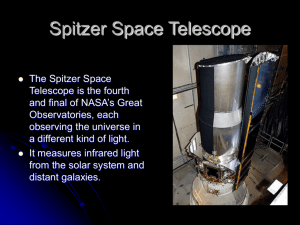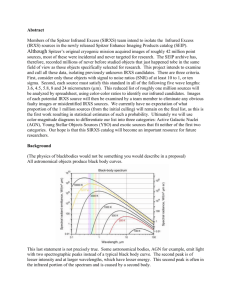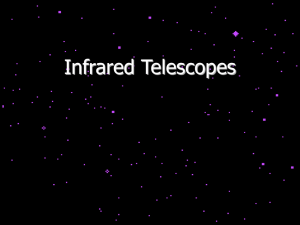The Spitzer Space Telescope
advertisement

The Universe in the Infrared What is the Spitzer Space Telescope, and how does it work? Images courtesy NASA/JPL - Caltech Funded by NASA’s Spitzer Science Center Outline NASA’s Great Observatories Introducing Spitzer Spitzer’s Launch Orbit Naming Spitzer The Telescope Instruments Future IR Telescopes The Universe in the Infrared Pilachowski / August 2005 Slide 2 NASA’s Great Observatories HST 1990 Compton GRO 1991 Chandra 1999 The Universe in the Infrared Spitzer is the final spacecraft in NASA's Great Observatories program Pilachowski / August 2005 Slide 3 Introducing Spitzer The Spitzer Space Telescope is a cryogenically cooled, infrared observatory in space. Spitzer can study objects ranging from our Solar System to the distant reaches of the Universe. The Universe in the Infrared Pilachowski / August 2005 Slide 4 Launch • Launched from KSC on 25 August 2003 • Lifetime: 2.5 years (minimum); 5+ years (goal) The Universe in the Infrared Pilachowski / August 2005 Slide 5 Heliocentric Orbit • Most space telescopes orbit the Earth • Spitzer orbits the Sun - trailing the Earth as it moves around the Sun • Spitzer is receding from Earth at 9.3 million miles (15 million kilometers) per year • Spitzer now trails the Earth in its orbit by about 20 million miles (~ 32 million kilometers) • By 2008, Spitzer will be about 56 million miles or 90 million kilometers away The Universe in the Infrared Pilachowski / August 2005 Slide 6 Named for Lyman Spitzer Lyman Spitzer was the driving force behind HST Founded the study of the interstellar medium Studied interstellar dust and star formation The Universe in the Infrared Pilachowski / August 2005 Slide 7 Introducing the Telescope The Universe in the Infrared Pilachowski / August 2005 Slide 8 Spitzer Specs Mirror: 85 cm (33.5”) diameter lightweight beryllium f/12 curvature Weight: Telescope: 851.5 kg He cryogen: 50.4 kg N propellent: 15.6 kg The Universe in the Infrared Pilachowski / August 2005 Slide 9 Keeping Spitzer Cold • Telescope operates at 5.5 K • Why? - Spitzer is itself a black body radiator, and must be colder than the astronomical sources it detects • How? – Heliocentric orbit – Solar shield/solar cells – Outer shell insulates and cools the telescope The Universe in the Infrared Pilachowski / August 2005 Slide 10 Keeping Spitzer’s Instruments Even Colder A tank of liquid helium is used to keep Spitzer’s instruments and detectors at 1.5 K The Universe in the Infrared Pilachowski / August 2005 Slide 11 Spitzer’s Instruments • IRAC – InfraRed Array Camera – images at 3.6, 4.5, 5.8, and 8 mm • IRS – InfraRed Spectrograph – mid-IR spectroscopy • MIPS – Multiband Imaging Photometer for Spitzer – images at 24, 70, and 160 mm IRS MIPS The Universe in the Infrared IRAC Pilachowski / August 2005 Slide 12 InfraRed Array Camera (IRAC) • Built at the Smithsonian Astrophysical Observatory • Simultaneous images in four IR passbands The Universe in the Infrared Pilachowski / August 2005 Slide 13 InfraRed Spectrometer • Built at Cornell University • Spectroscopy in the mid-IR The Universe in the Infrared Pilachowski / August 2005 Slide 14 Multiband Imaging Photometer for Spitzer (MIPS) Built at the University of Arizona • Three detector arrays – 128x128 pixel Si:As for 24 mm – 32x32 pixel Ge:Ga for 70 mm – 2x20 pixel Ge:Ga for 160 mm The Universe in the Infrared Pilachowski / August 2005 Slide 15 Spitzer Focal Plane Spitzer instruments are arranged in fixed locations on the Spitzer focal plane The telescope is rotated to move a particular science target to the right position for the instrument to be used Other instruments record data for “serendipitous” fields The Universe in the Infrared Pilachowski / August 2005 Slide 16 Spitzer Operations What Is Spitzer Doing Now? www.spitzer.caltech.edu/about/now.shtml The Universe in the Infrared Pilachowski / August 2005 Slide 17 Future Infrared Satellites 2007: Herschel Space Observatory - a European Space Agency infraredsubmillimeter mission planned for 2007 to study galaxy formation, interstellar matter, star formation and the atmospheres of comets and planets. The Universe in the Infrared 2007: Planck Surveyor - European Space Agency far infraredsubmillimeter mission planned for 2007 to study Cosmic Background Radiation. 2010: The James Webb Space Telescope, planned for launch in about 2011, is a visible/infrared space mission to study the early universe and the formation of galaxies, stars and planets. Pilachowski / August 2005 Slide 18





